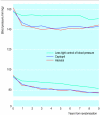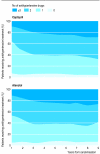Efficacy of atenolol and captopril in reducing risk of macrovascular and microvascular complications in type 2 diabetes: UKPDS 39. UK Prospective Diabetes Study Group
- PMID: 9732338
- PMCID: PMC28660
Efficacy of atenolol and captopril in reducing risk of macrovascular and microvascular complications in type 2 diabetes: UKPDS 39. UK Prospective Diabetes Study Group
Abstract
Objective: To determine whether tight control of blood pressure with either a beta blocker or an angiotensin converting enzyme inhibitor has a specific advantage or disadvantage in preventing the macrovascular and microvascular complications of type 2 diabetes.
Design: Randomised controlled trial comparing an angiotensin converting enzyme inhibitor (captopril) with a beta blocker (atenolol) in patients with type 2 diabetes aiming at a blood pressure of <150/<85 mm Hg.
Setting: 20 hospital based clinics in England, Scotland, and Northern Ireland.
Subjects: 1148 hypertensive patients with type 2 diabetes (mean age 56 years, mean blood pressure 160/94 mm Hg). Of the 758 patients allocated to tight control of blood pressure, 400 were allocated to captopril and 358 to atenolol. 390 patients were allocated to less tight control of blood pressure.
Main outcome measures: Predefined clinical end points, fatal and non-fatal, related to diabetes, death related to diabetes, and all cause mortality. Surrogate measures of microvascular and macrovascular disease included urinary albumin excretion and retinopathy assessed by retinal photography.
Results: Captopril and atenolol were equally effective in reducing blood pressure to a mean of 144/83 mm Hg and 143/81 mm Hg respectively, with a similar proportion of patients (27% and 31%) requiring three or more antihypertensive treatments. More patients in the captopril group than the atenolol group took the allocated treatment: at their last clinic visit, 78% of those allocated captopril and 65% of those allocated atenolol were taking the drug (P<0.0001). Captopril and atenolol were equally effective in reducing the risk of macrovascular end points. Similar proportions of patients in the two groups showed deterioration in retinopathy by two grades after nine years (31% in the captopril group and 37% in the atenolol group) and developed clinical grade albuminuria >=300 mg/l (5% and 9%). The proportion of patients with hypoglycaemic attacks was not different between groups, but mean weight gain in the atenolol group was greater (3.4 kg v 1.6 kg).
Conclusion: Blood pressure lowering with captopril or atenolol was similarly effective in reducing the incidence of diabetic complications. This study provided no evidence that either drug has any specific beneficial or deleterious effect, suggesting that blood pressure reduction in itself may be more important than the treatment used.
Figures







Comment in
-
Diabetes: a time for excitement-and concern. Hopeful signs exist that the ravages of diabetes can be tamed.BMJ. 1998 Sep 12;317(7160):691-2. doi: 10.1136/bmj.317.7160.691. BMJ. 1998. PMID: 9732333 Free PMC article. No abstract available.
-
Combined high blood pressure and glucose in type 2 diabetes: double jeopardy. British trial shows clear effects of treatment, especially blood pressure reduction.BMJ. 1998 Sep 12;317(7160):693-4. doi: 10.1136/bmj.317.7160.693. BMJ. 1998. PMID: 9732334 Free PMC article. No abstract available.
-
Treating type 2 diabetes. Study was conducted in exemplary fashion.BMJ. 1999 Mar 6;318(7184):666-7; author reply 668. doi: 10.1136/bmj.318.7184.666a. BMJ. 1999. PMID: 10066218 Free PMC article. No abstract available.
-
Treating type 2 diabetes. Difference needs to be explained.BMJ. 1999 Mar 6;318(7184):667; author reply 668. BMJ. 1999. PMID: 10215364 No abstract available.
-
Treating type 2 diabetes. Important findings should not be published in two journals.BMJ. 1999 Mar 6;318(7184):667-8. BMJ. 1999. PMID: 10215366 No abstract available.
References
-
- Kasiske B, Kalil RSN, Ma JZ, Liao M, Keane WF. Effect of antihypertensive therapy on the kidney in patients with diabetes: a meta-regression analysis. Ann Intern Med. 1993;118:129–138. - PubMed
-
- Passa P, Leblanc H, Marre M. Effects of enalapril in insulin-dependent diabetic subjects with mild to moderate uncomplicated hypertension. Diabetes Care. 1987;10:200–204. - PubMed
-
- Laffel LM, McGill JB, Gans DJ. The beneficial effect of angiotensin-converting enzyme inhibition with captopril on diabetic nephropathy in normotensive IDDM patients with microalbuminuria. North American Microalbuminuria Study Group. Am J Med. 1995;99:497–504. - PubMed
Publication types
MeSH terms
Substances
LinkOut - more resources
Full Text Sources
Other Literature Sources
Medical
